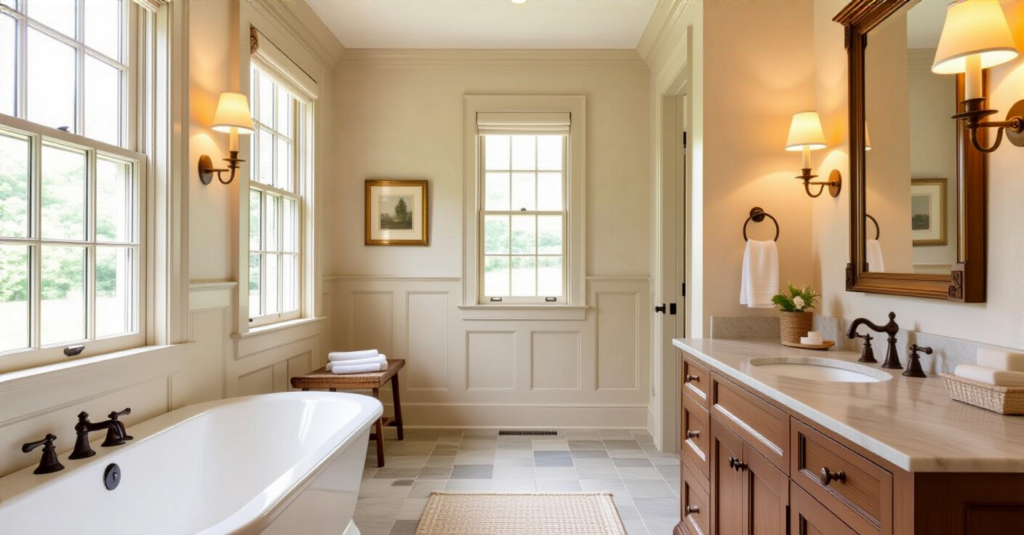You know the biggest challenge my clients have, especially those of us working from home? It’s not finding a place to put their laptop. It’s finding a place to put themselves down at the end of the day. A space where the noise of notifications and deadlines truly fades away. We need a sanctuary.
And honestly, the bathroom is one of the last true places of solitude in a modern home. It’s the one room with a lock on the door where you’re expected to be alone. So when people ask me about creating a Colonial-style bathroom, I don’t see it as just a design project. I see it as building the ultimate personal retreat. It’s about crafting a corner of the world that feels calm, timeless, and completely yours.
But everyone gets intimidated. They think “authentic” means “uncomfortable.” Or they see a picture on Pinterest and end up with a room that feels like a movie set instead of a real, livable space. The secret isn’t just picking old-looking stuff. It’s about understanding the feeling behind the style—simple, crafted, and deeply calming—and then thoughtfully weaving in the modern comforts we actually need. Let’s walk through how to do it right.
Foundational Planning: Defining Your Colonial Vision
This is the daydreaming part, but with a purpose. It’s where you get clear on your vision before a single tile is bought or a single wall is touched. Skipping this is how you end up with a project that’s over budget and doesn’t quite feel right. Getting this right is how you create a space that feels like it has a soul.
1. Determine Your Core Era for Design Accuracy
Can we talk about how everyone just throws the word “Colonial” around? It covers a couple of hundred years. Trying to design for all of it at once is a recipe for a mess. You need to pick your flavor. Are you more of a rustic, Early American person with simple, sturdy lines? Or a more refined, symmetrical Georgian fan? Or do you lean toward the slightly more delicate, classical details of the Federal period?
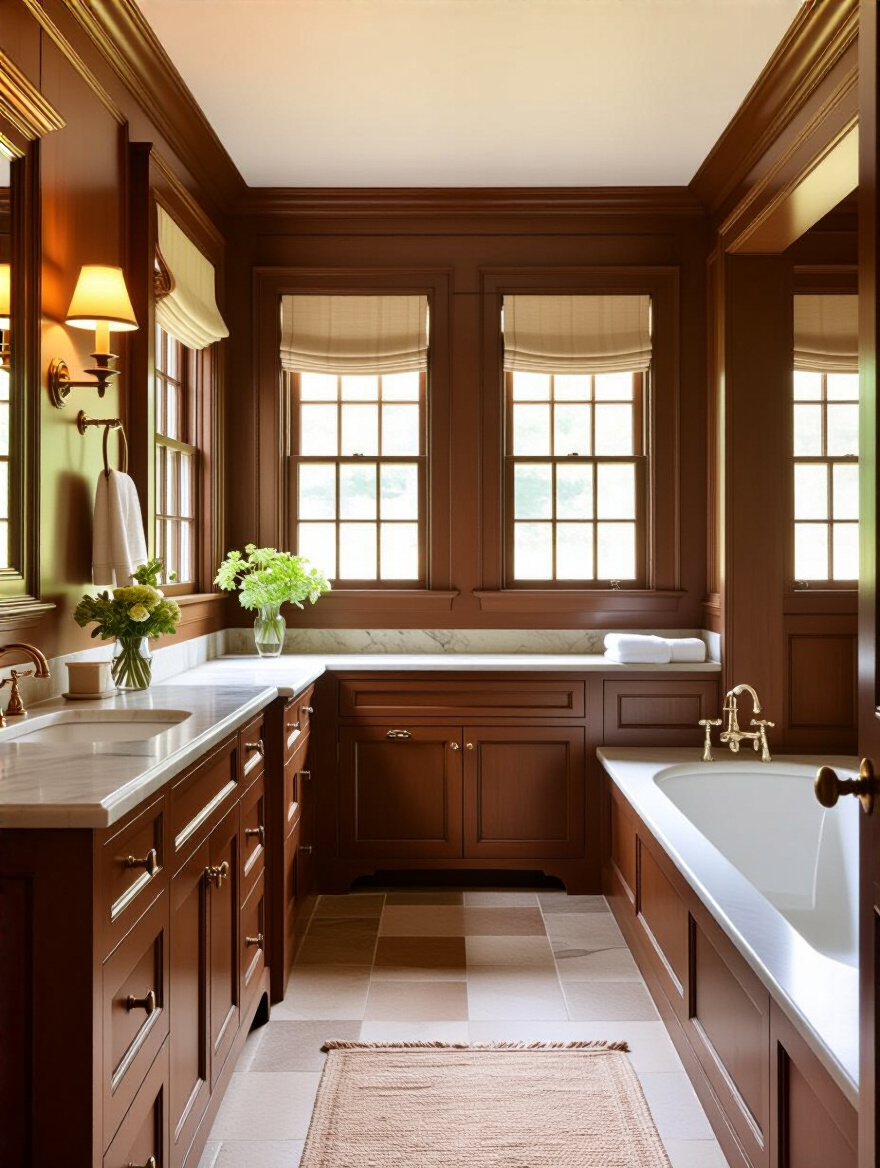
Don’t get bogged down in a history lesson. Just look at a few examples of each and see which one feels like you. Choosing an era is your design roadmap. It tells you which wood to use, which faucet shape to look for, and which colors will feel right. It stops you from getting overwhelmed by a million choices online and keeps your project focused and coherent. It’s the difference between a curated space and a random collection of “old-timey” things.
So, let this be your first, most important decision. It’s the compass that will guide every choice you make from here on out.
2. Prioritize Practicality Without Sacrificing Authenticity
Here’s the biggest myth I want to bust: an authentic period bathroom has to be inconvenient. That you have to give up good water pressure or decent lighting to get the look. Absolutely not. The entire point of creating a retreat is for it to be comfortable. A bathroom that doesn’t function well isn’t a retreat; it’s a frustration.
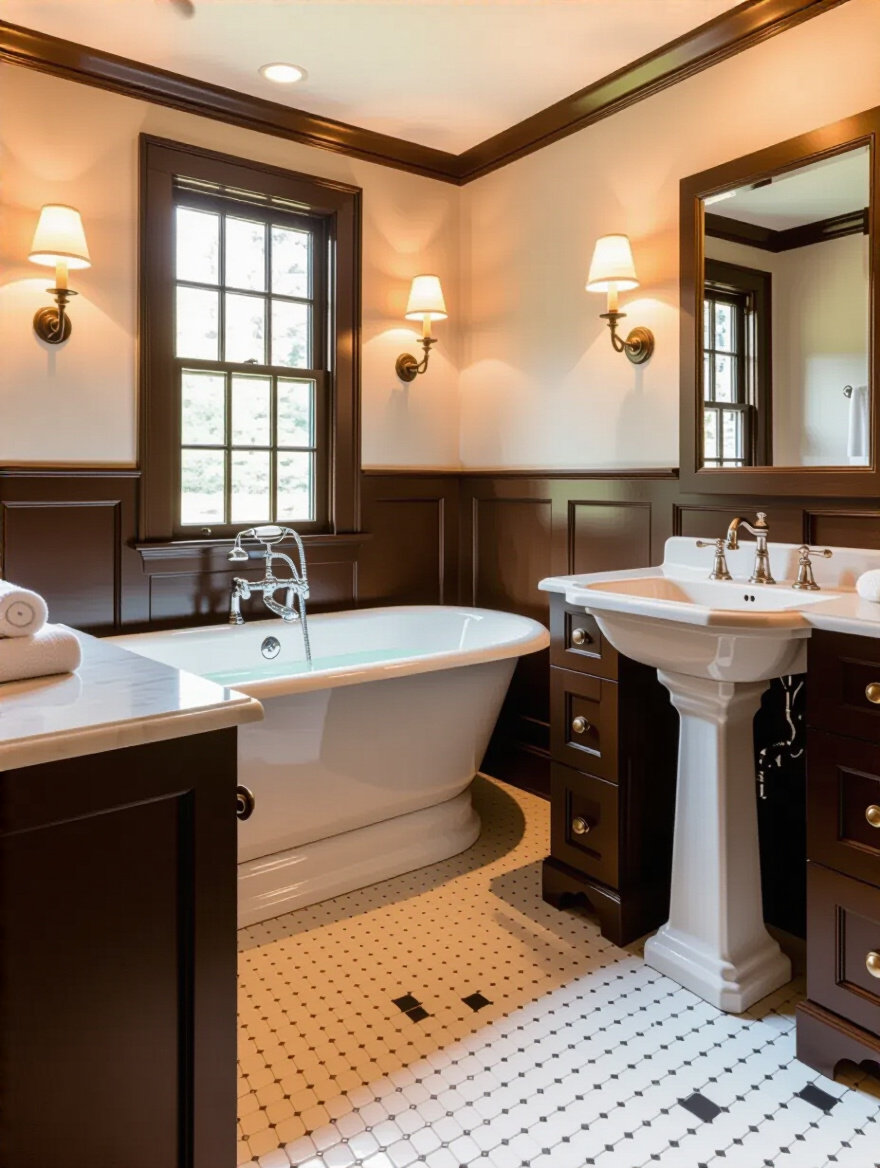 Clawfoot Tub, Pedestal Sink, and warm period-style lighting blending authentic design with modern practicality” class=”wp-image-2107″/>
Clawfoot Tub, Pedestal Sink, and warm period-style lighting blending authentic design with modern practicality” class=”wp-image-2107″/>The goal is invisible modernization. You want modern performance hidden inside a historical package. Think of a faucet that looks like a vintage hand-pump but has a high-quality ceramic disc valve inside that won’t drip. Or a ventilation fan that’s whisper-quiet and hidden behind a decorative iron-look grille. This is where you get to be clever. It’s about having your cake and eating it, too—the historic charm and the 21st-century comfort.
This is my core philosophy in a nutshell: a space has to work for the way we live now. Otherwise, it’s just a museum piece, and you don’t live in a museum.
3. Select Authentic Colonial Color Palettes Strategically
The colors used in the Colonial era were made from the earth—clays, minerals, and plants. That’s why they feel so natural and calming. They don’t scream at you like a lot of modern, synthetic colors do. Think about those soft, dusty blues, sage greens, buttery yellows, and warm, rusty reds. They have a certain quietness to them.
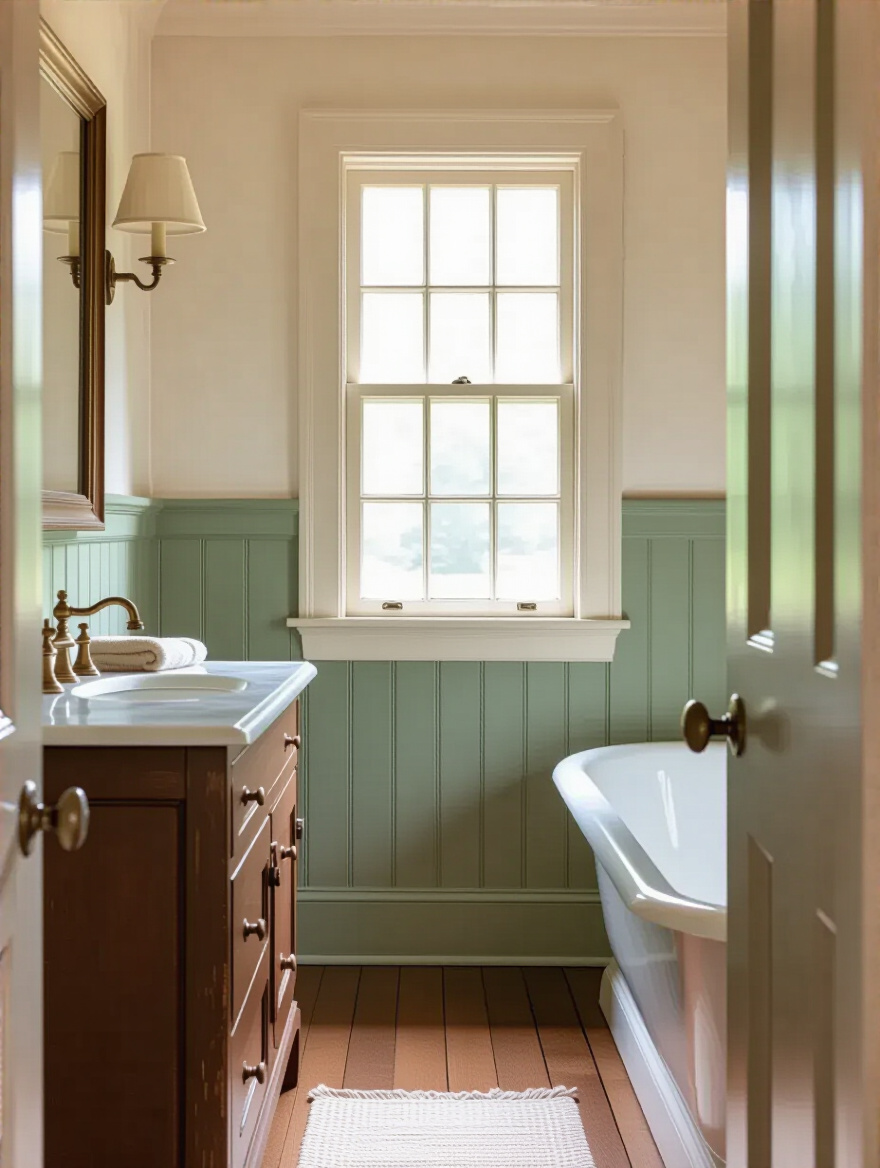
Your job is to build a palette that creates a mood. Start with a main wall color, something muted that will be your backdrop. Then, pick a color for the trim—often an off-white or a cream—to create soft contrast. Finally, choose an accent color, a slightly richer tone for small details. And please, test your swatches on the actual walls. The light in your bathroom will change how a color looks dramatically.
A client of mine once fell in love with a deep Prussian blue. In the store, it looked amazing. In his small, north-facing bathroom, it felt like a cave. We switched to a warmer, more golden ochre, and the whole room came to life. Color isn’t just decoration; it’s energy.
4. Optimize Layout for Period Fixture Placement
Older homes, and the fixtures that go in them, have different proportions. A grand clawfoot tub needs room to breathe. A pedestal sink, unlike a bulky vanity, opens up the floor but offers zero counter space. So you can’t just swap out modern fixtures for period ones and call it a day. You have to think about flow.
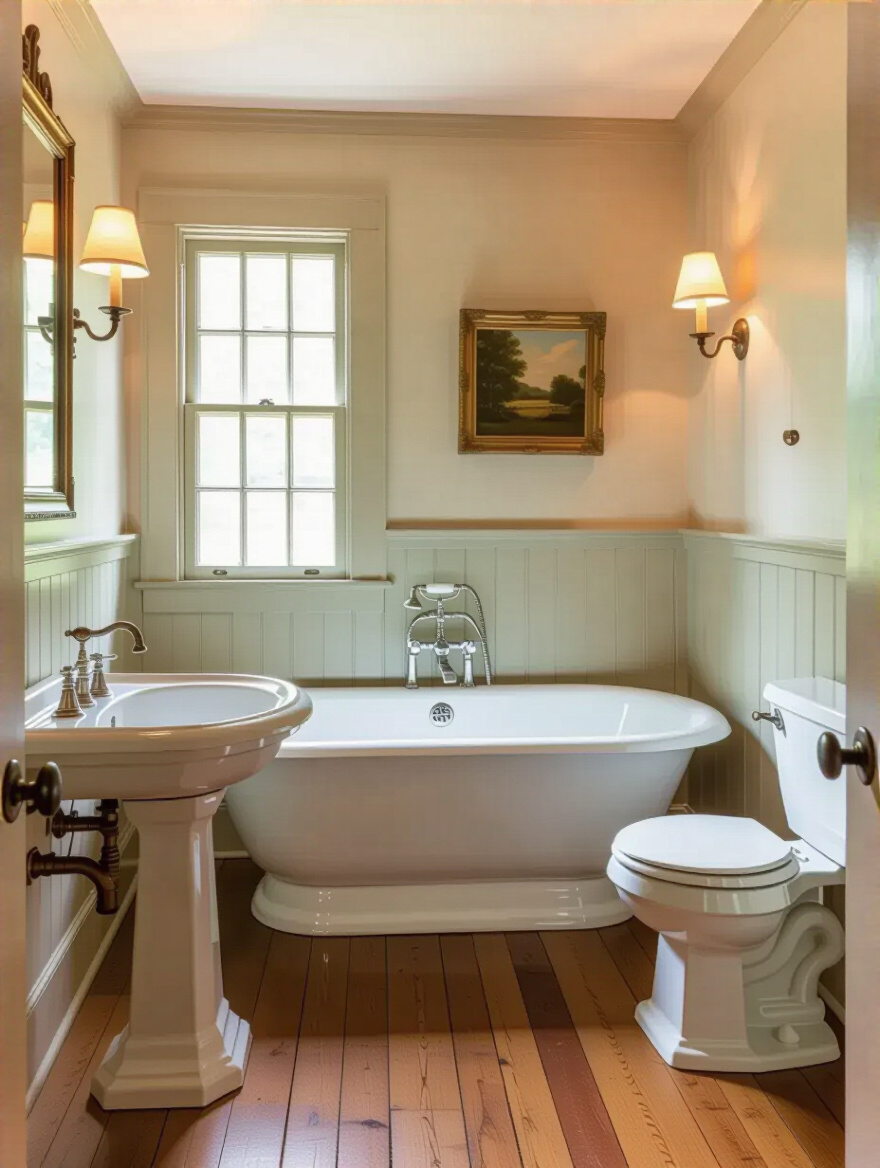
Grab some painter’s tape and mark out the footprints of your chosen fixtures on the floor. Can you walk around the tub comfortably? Does the door swing open without hitting the toilet? Can you open the medicine cabinet without bumping your head on the faucet? It sounds basic, but you’d be surprised how many people forget to do this.
This is all about making the room work for you on a practical, daily basis. A beautiful bathroom that you’re constantly bumping into things in will lose its charm fast. The goal is grace and ease, not a daily obstacle course.
5. Budget Wisely for Quality Period Reproductions
Let me give you a shortcut I wish I’d known earlier: not every piece in the room needs to be a top-of-the-line, expensive reproduction. You just need to be smart about where you spend your money. I call it the “hero” piece method. Your tub, your sink, and your main faucet are the heroes of the room. They get the most attention and have the biggest impact. Splurge on those.
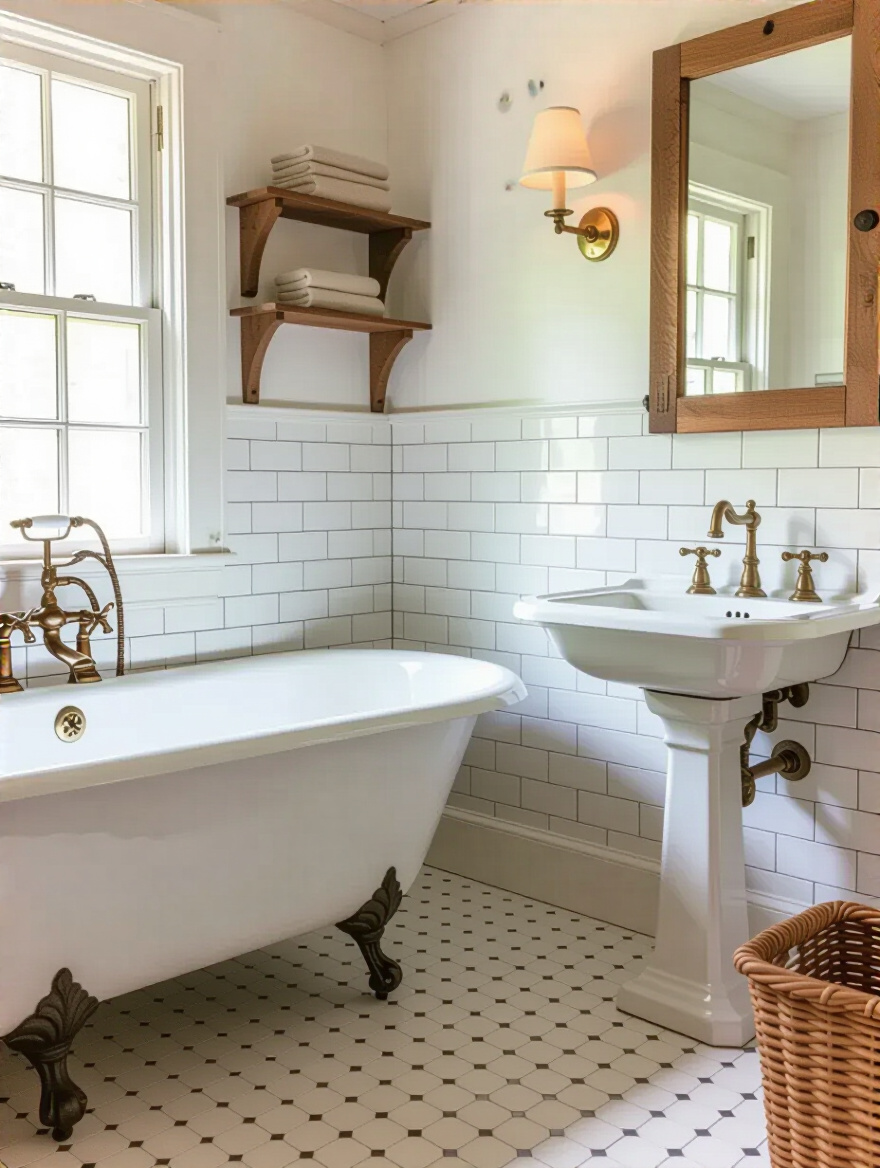
For other things, like a towel hook or a simple wall sconce, you can often find more affordable options that still fit the aesthetic. The trick is to invest in the things you touch and use every day and the things that are the main visual focus. People will notice a high-quality, solid brass faucet, but they won’t care if the toilet paper holder is a simpler design.
I had a client who tried to save money on their tub and ended up with a cheap acrylic model that creaked and lost heat instantly. They hated it. A year later, we replaced it with a proper cast-iron one. Buy the right hero pieces once, and you’ll love them forever.
6. Source Inspiration from Diverse Historical Colonial Examples
Okay, final planning step. Don’t just type “Colonial bathroom” into Pinterest. You’ll get the same five “Colonial Revival” bathrooms a million times over. The real magic happens when you dig a little deeper. Look at Dutch Colonial homes in the Hudson Valley with their charming tilework. Or the Spanish Colonial influence in Florida and the Southwest, with its terracotta and dark woods.
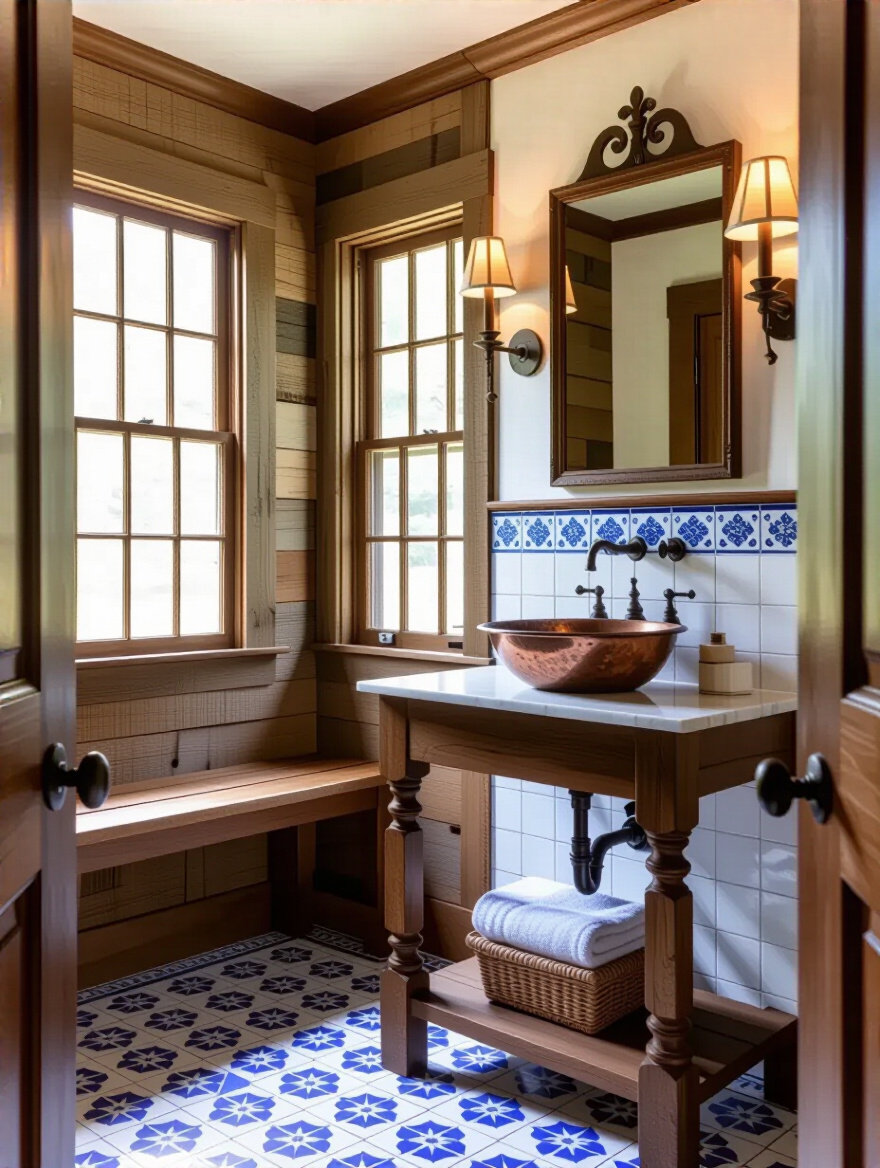
These regional differences are what will give your space its unique personality. It’s what makes it feel authentic and storied, not like a page from a catalog. Visiting a historical house in your area or looking through architectural archives online can be incredibly inspiring. You’ll find details and ideas that no one else has.
This is how you create a space that tells a story—your story, informed by real history. It makes the final result so much richer.
Selecting Key Fixtures & Materials for Core Authenticity
Alright, planning is done. Now for the fun part—choosing the big, beautiful pieces that will define your retreat. These are the foundational elements that will do the heavy lifting in creating that authentic Colonial feel.
7. Choose Classic Clawfoot Tubs for Timeless Appeal
Is there anything that says “relaxing soak” more than a clawfoot tub? It’s the ultimate bathroom centerpiece. Its freestanding nature makes it feel like a sculpture, and because it’s not surrounded by a bulky deck, it can actually make a small room feel larger. It’s the visual anchor for the entire space.
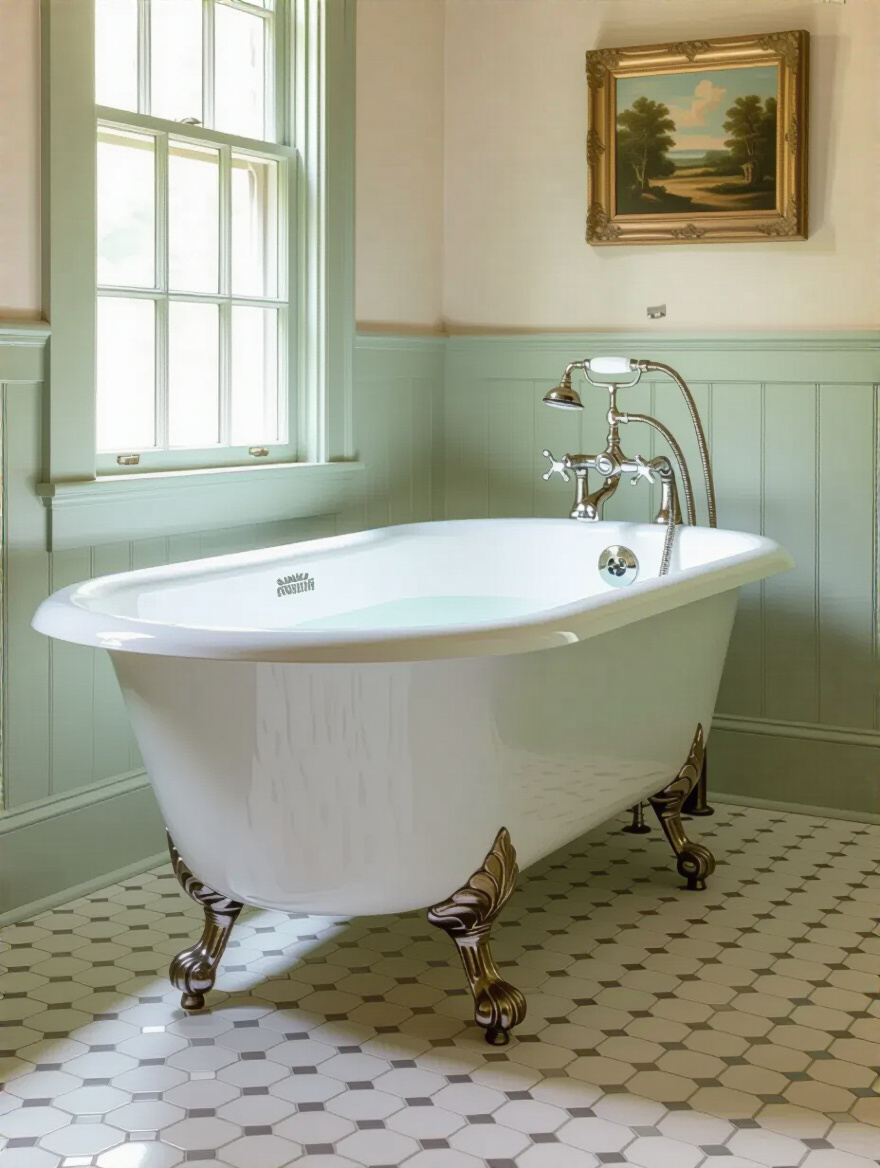
Now, a quick word on materials. Cast iron is the original and the best. It holds heat like nothing else, so your bath stays warmer for longer. But it’s incredibly heavy, so you have to be sure your floor can support it. Acrylic is a lighter, more affordable option, but it doesn’t have the same solid feel. If you go with acrylic, here’s a pro tip: have your contractor spray foam insulation on the underside. It dramatically improves its heat retention.
A long soak in a deep tub is the perfect antidote to a long day of Zoom calls. It’s an investment in your well-being.
8. Install Elegant Pedestal Sinks for Period Authenticity
Modern vanities are great for storage, but they can be big, bulky boxes that eat up visual space. A pedestal sink, on the other hand, is all grace and airiness. It hearkens back to the simple washstands of the 18th century and is essential for achieving an authentic, uncluttered look. It instantly makes a bathroom feel lighter and more open.
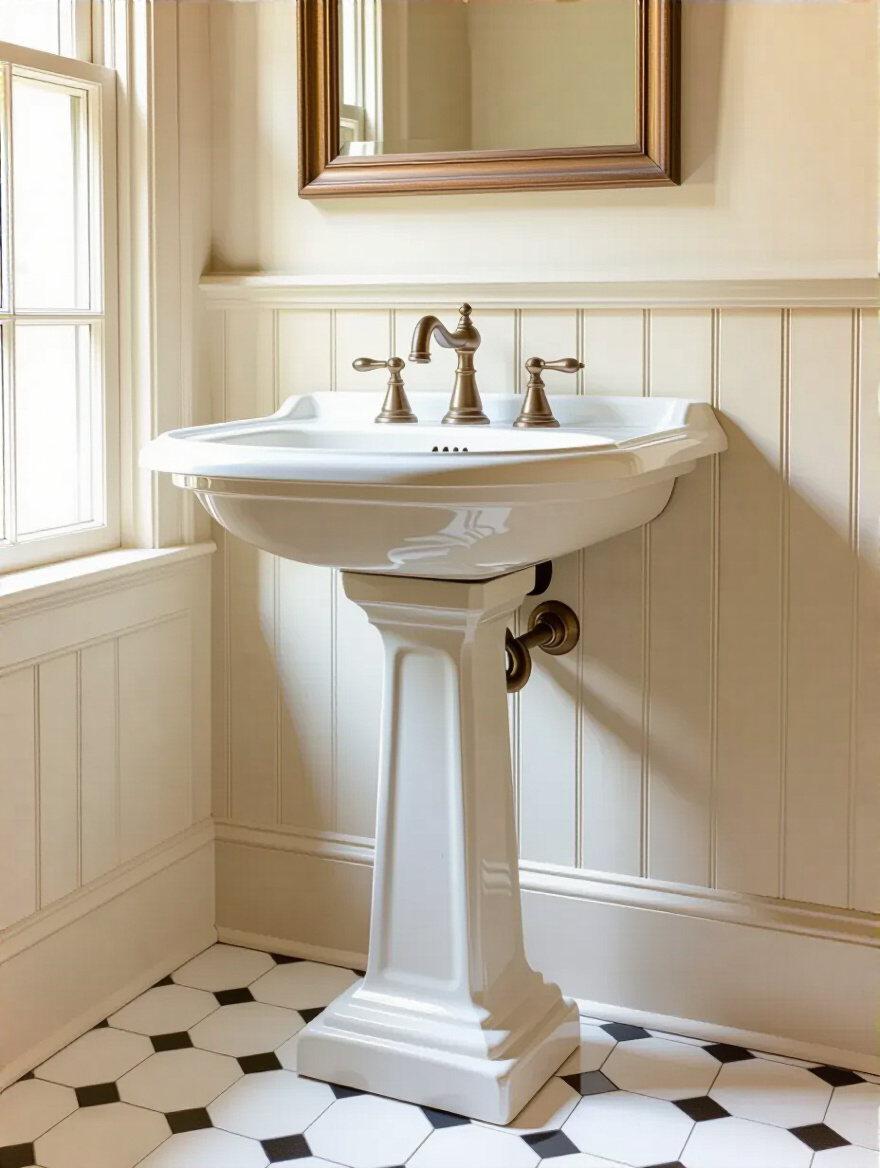
The obvious downside is the lack of storage. This is where you get creative. The Colonial solution wasn’t a built-in cabinet; it was a separate piece of furniture. A small antique chest of drawers or a simple wall-mounted cabinet can hold your essentials while adding another layer of character to the room. This forces you to be intentional about what you keep out, which is a great way to reduce clutter.
A pedestal sink is a commitment to simplicity. It encourages a less-is-more approach that is deeply calming for the mind.
9. Consider High-Tank Toilets for an Iconic Colonial Look
This one is for those who are truly committed to the look. The high-tank toilet, with its pull chain and elevated tank, is an undeniable statement piece. It’s dramatic, it’s elegant, and it screams historical authenticity. It instantly transports you to another era.
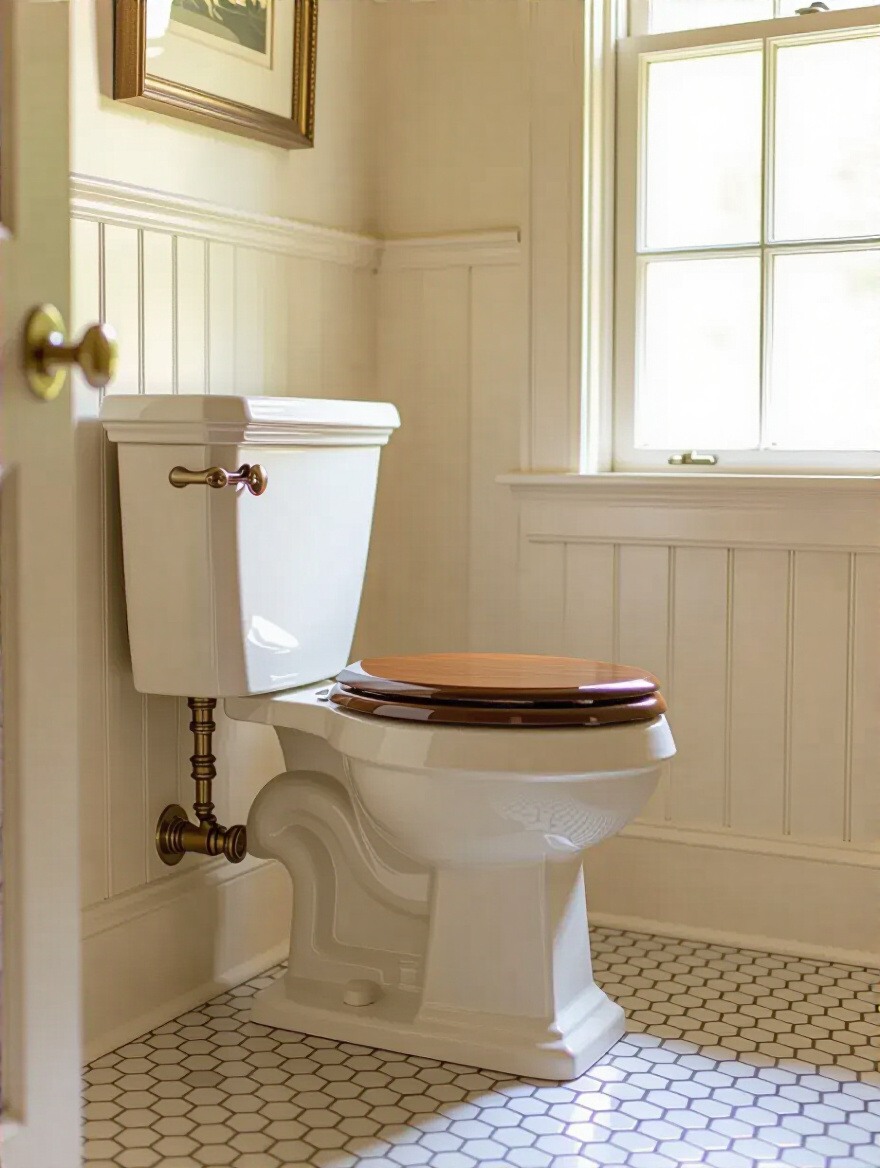
The good news is that modern reproductions have all the vintage style but with today’s water-saving and efficient flushing technology. You don’t have to sacrifice performance for the look. You do, however, need the right space for it—namely, a high enough ceiling. It’s a vertical element, so it draws the eye upward and can make a room feel taller.
This isn’t a choice for everyone, but if you have the space and the boldness, there’s nothing else quite like it for period character.
10. Select Wide-Plank Wood or Hex Tile for Flooring
Your floor is the foundation of the room’s entire feel. Wide-plank wood—especially something a bit distressed or reclaimed—adds incredible warmth and a rustic, authentic character. It feels solid and grounding underfoot. If you go this route, make sure it’s properly sealed for a bathroom environment. Engineered hardwood is often a great, stable choice here.
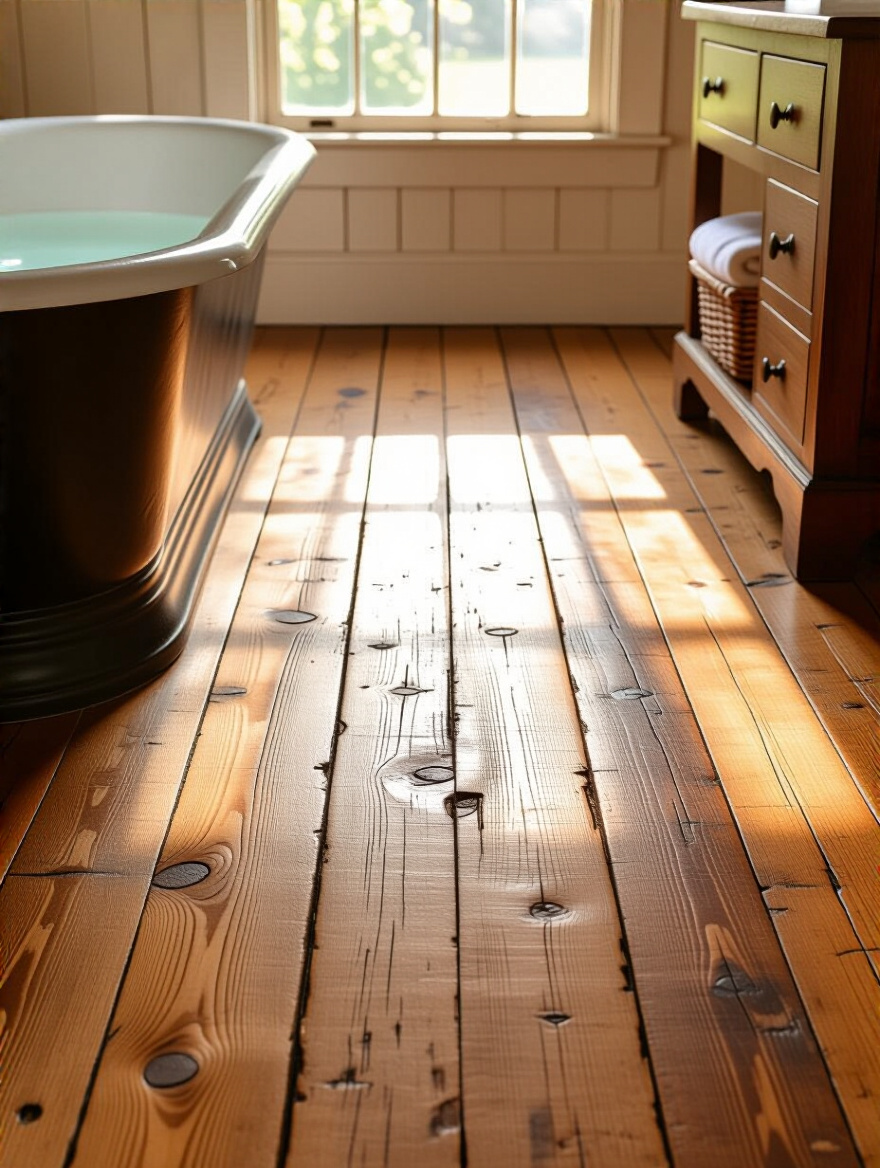
Classic hexagonal tiles are another perfect choice, especially for a Colonial Revival look. They provide a clean, graphic pattern that feels both vintage and timeless. Small one-or-two-inch hex tiles, especially in black and white, are a can’t-miss option. A pro tip: consider installing radiant heat mats underneath. It’s an invisible modern luxury that makes stepping out of the tub on a cold morning a true joy.
The right flooring isn’t just a surface; it’s a key part of the sensory experience of the room.
11. Apply Period-Correct Wainscoting or Plaster Walls
This is a detail that separates the good rooms from the great ones. Standard drywall is flat and lifeless. A wall with wainscoting or a proper plaster finish has texture, depth, and character. It’s the difference between a print and an oil painting. Plaster, with its subtle imperfections and soft texture, absorbs and reflects light in a much warmer way than drywall.
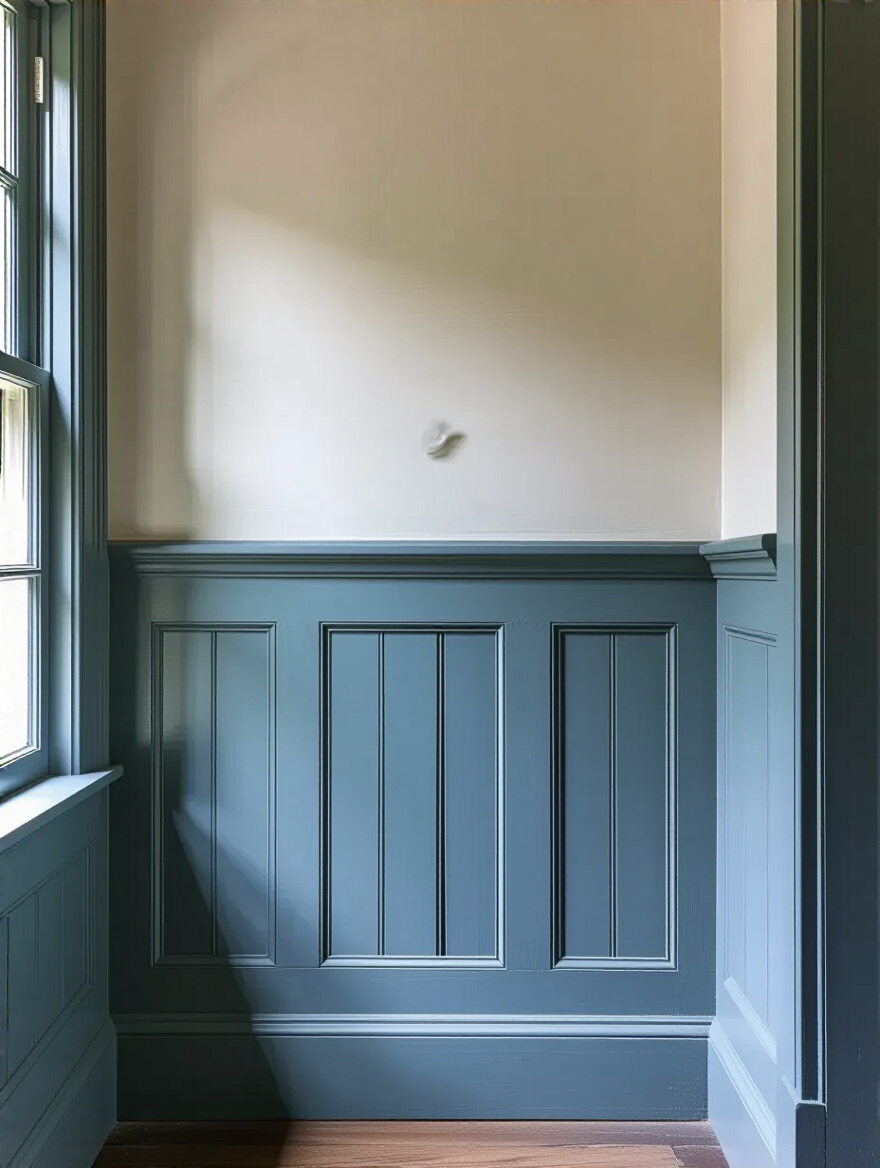
Wainscoting, like beadboard or simple recessed panels, adds architectural interest and protects the lower part of the walls. It was a practical choice in Colonial times, and it brings that same sense of sturdiness and craft to a modern room. Painting it a contrasting color from the upper wall adds another layer of historical detail.
I once worked on a project where we swapped out the flat drywall for simple board-and-batten wainscoting. The change was astounding. The room instantly felt more substantial, more intentional, and deeply comforting.
12. Integrate Blending Shower Enclosures Seamlessly
So you need a modern, walk-in shower. How do you do it without a giant glass box screaming “2024!” in the middle of your 18th-century retreat? The trick is to make it disappear. Build it into an alcove, so it feels like a part of the architecture, not something just plonked down in the corner.
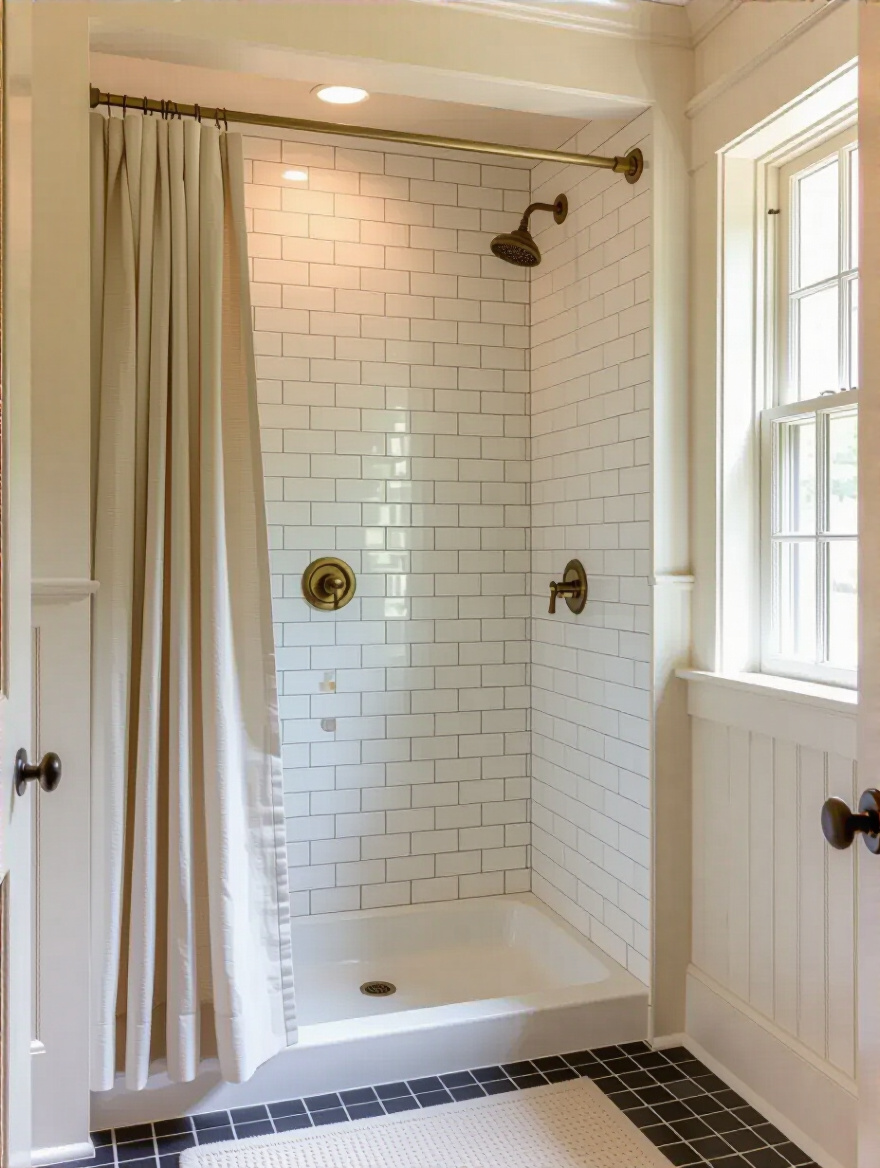
Use the same tile as you might have elsewhere, like a simple subway tile. And ditch the complex metal framing. Opt for a simple, frameless glass panel if you must, but an even better choice is a high-quality, heavy linen or cotton shower curtain on a simple brass or iron rod. This feels much more historically appropriate and adds a layer of softness.
The goal is for the shower to be a quiet, functional space that doesn’t pull focus from the beautiful tub and sink. It’s a supporting actor, not the star of the show.
13. Optimize Plumbing Lines for Authentic Fixture Style
This is the behind-the-scenes work that makes all the difference. Modern plumbing is all about PEX pipes and plastic fittings hidden in the walls. That’s great, but when plumbing is visible—like the water lines going to a clawfoot tub or the trap under a pedestal sink—it has to look the part.
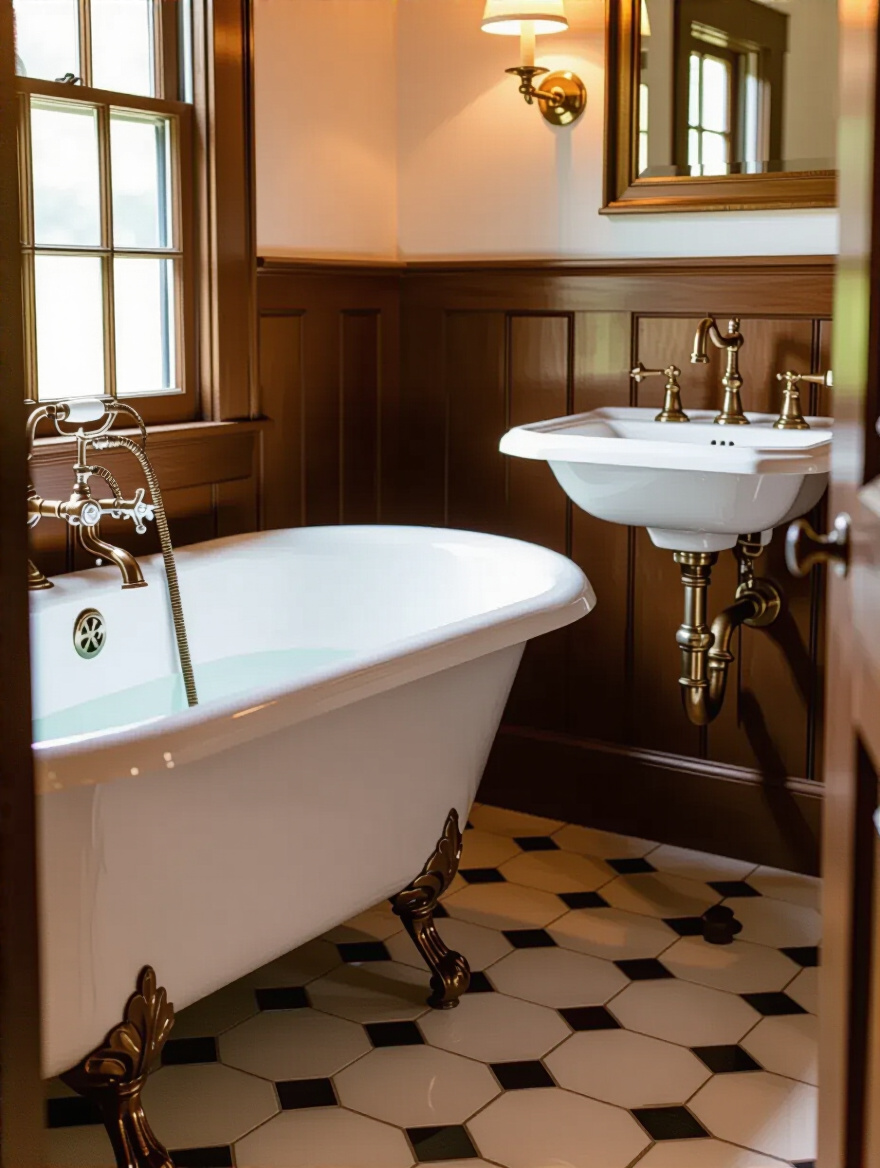
This means planning ahead with your plumber to use beautiful, period-appropriate materials for the visible parts. Think polished nickel or unlacquered brass pipes. A graceful, curved P-trap under the sink is a beautiful detail that most people won’t consciously notice, but it contributes to the overall authentic feel. Exposed plastic or braided steel supply lines will shatter the illusion instantly.
It’s one of those details that shows you’ve thought about everything, creating a sense of quality and craftsmanship that runs through the whole space.
Period-Perfect Details & Furnishings That Elevate the Space
You’ve got the big pieces in place. The room has good bones. Now it’s time to bring it to life with the smaller details. This is where you layer in personality and warmth, turning a well-designed room into a soulful retreat.
14. Pick Authentic Metal Finishes for All Hardware
The BS everyone believes is that all shiny things are created equal. They are not. A cheap, “brass-colored” finish on a faucet will look terrible in a year. The real deal is unlacquered brass. It’s what’s called a “living finish.” It arrives shiny but will slowly darken and patina over time, gaining a rich, warm, and unique character that tells the story of your home. The same goes for forged iron or oil-rubbed bronze.
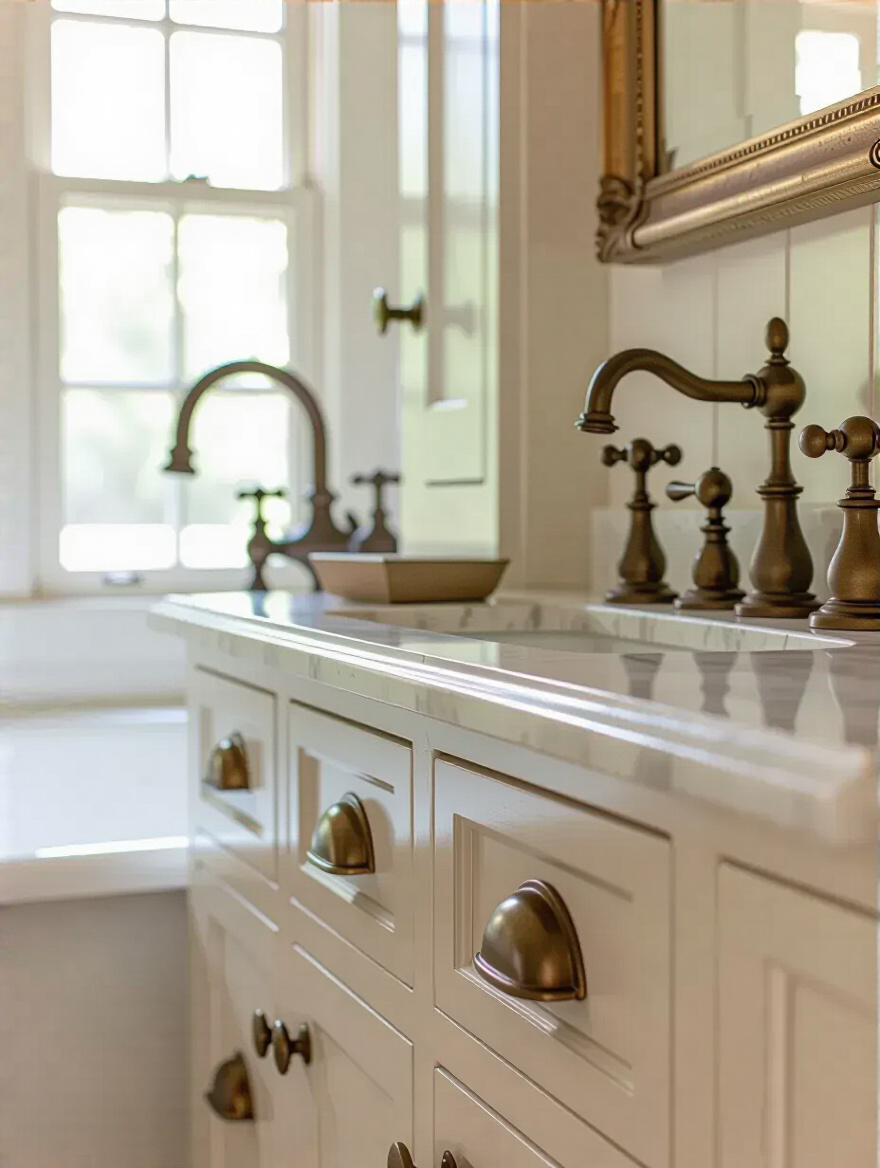
You want materials that age gracefully, not things that just get worn out. This goes for everything from your faucet to your drawer pulls to your light fixtures. Consistency is key. Stick to one or two complementary finishes to create a cohesive, calming look.
Embrace the patina! It’s the sign of a space that’s loved and lived-in, not a showroom that’s frozen in time.
15. Incorporate Rich, Natural Wood for Warmth and Character
A bathroom can easily feel cold and sterile with all that tile and porcelain. The antidote is wood. The warmth and natural grain of a wood-framed mirror, a simple wooden stool next to the tub, or open shelving made from reclaimed timber can completely change the feeling of a room.

It provides a crucial textural contrast and a connection to the natural world, which is a core tenet of Colonial design. Look for woods with character—oak, cherry, or even a dark-stained pine. And opt for a matte or oil finish rather than a thick, glossy polyurethane. You want to feel the wood, not a layer of plastic on top of it.
This is a simple way to inject a huge amount of soul and warmth. It’s the material that makes a house feel like a home.
16. Design Warm, Diffused Lighting for Ambiance
Harsh, overhead lighting is the enemy of a relaxing retreat. You want layers of warm, gentle light. Colonial-era lighting came from candles and firelight, so we’re aiming to replicate that soft, golden glow. This means avoiding a grid of recessed can lights as your only source.
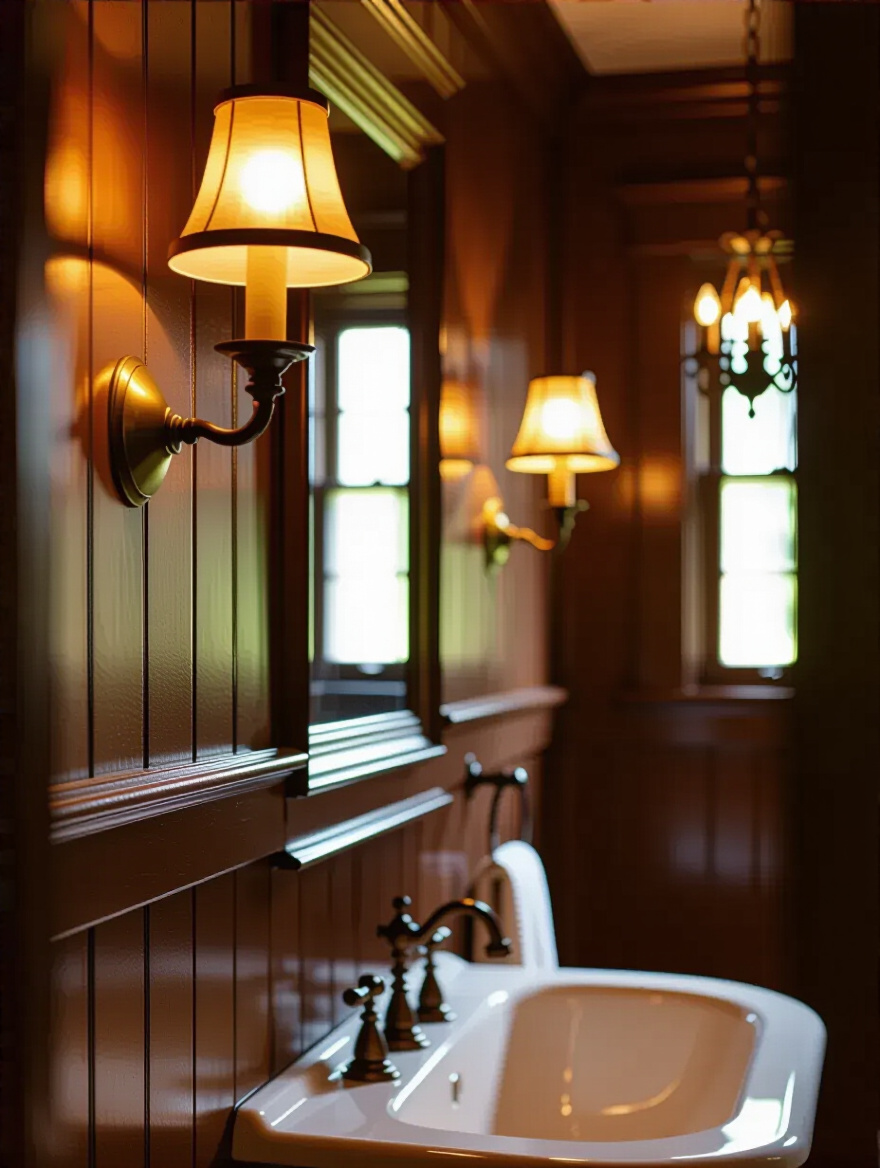
Instead, think in layers. Start with a pair of sconces flanking the mirror for beautiful, shadow-free task lighting. Add a small, simple chandelier or pendant as a central ambient light source. And put everything—I repeat, everything—on a dimmer switch. This is non-negotiable. It allows you to go from bright, functional light for getting ready in the morning to a low, moody glow for an evening soak.
Always choose light bulbs in a warm color temperature (around 2700K). It’s the secret to creating an atmosphere that feels cozy and inviting, not like a doctor’s office.
17. Choose Classic Mirrors and Medicine Cabinets
The mirror is the focal point over your sink, so choose wisely. A simple, beautifully crafted wood frame is often all you need. The proportions should complement the sink, not overpower it. If you need storage, a recessed medicine cabinet is the perfect solution. It gives you hidden space without projecting into the room.
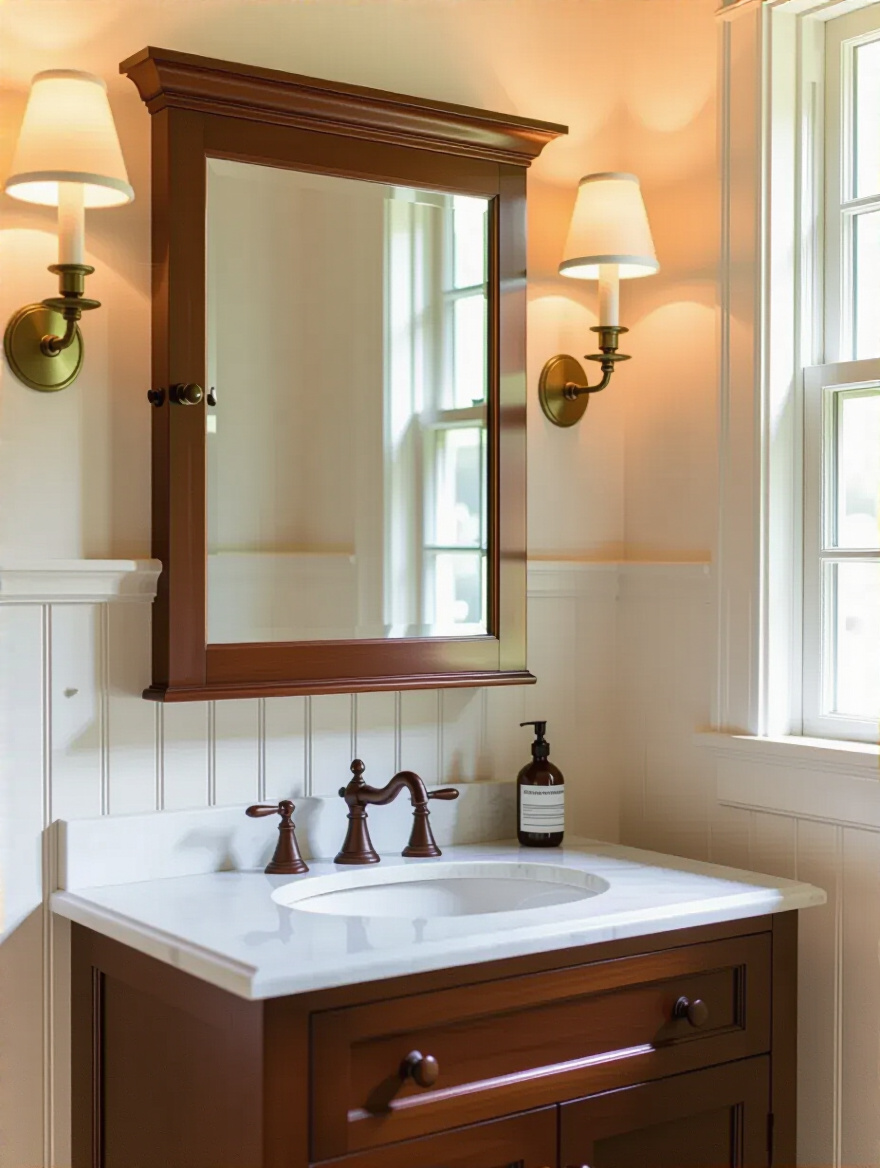
Look for models with a simple, plain door that you can paint to match the wall or trim, making it almost disappear. The key is to avoid anything too ornate. Colonial design is rooted in a certain simplicity and modesty. The beauty comes from the quality of the materials and the rightness of the proportions.
A client once wanted a huge, gilded rococo mirror. I gently steered them toward a classic Federal-style mirror with a delicate cherry frame. It was a fraction of the size, but it had ten times the grace and felt perfect in the space.
18. Select Simple Linen or Cotton Textiles for Softness
Your textiles—towels, shower curtain, bath mat—are the final layer of softness and texture. Forget fancy, patterned polyester. Stick to natural fibers like linen and cotton. They were the materials of the era, and they feel and perform infinitely better.
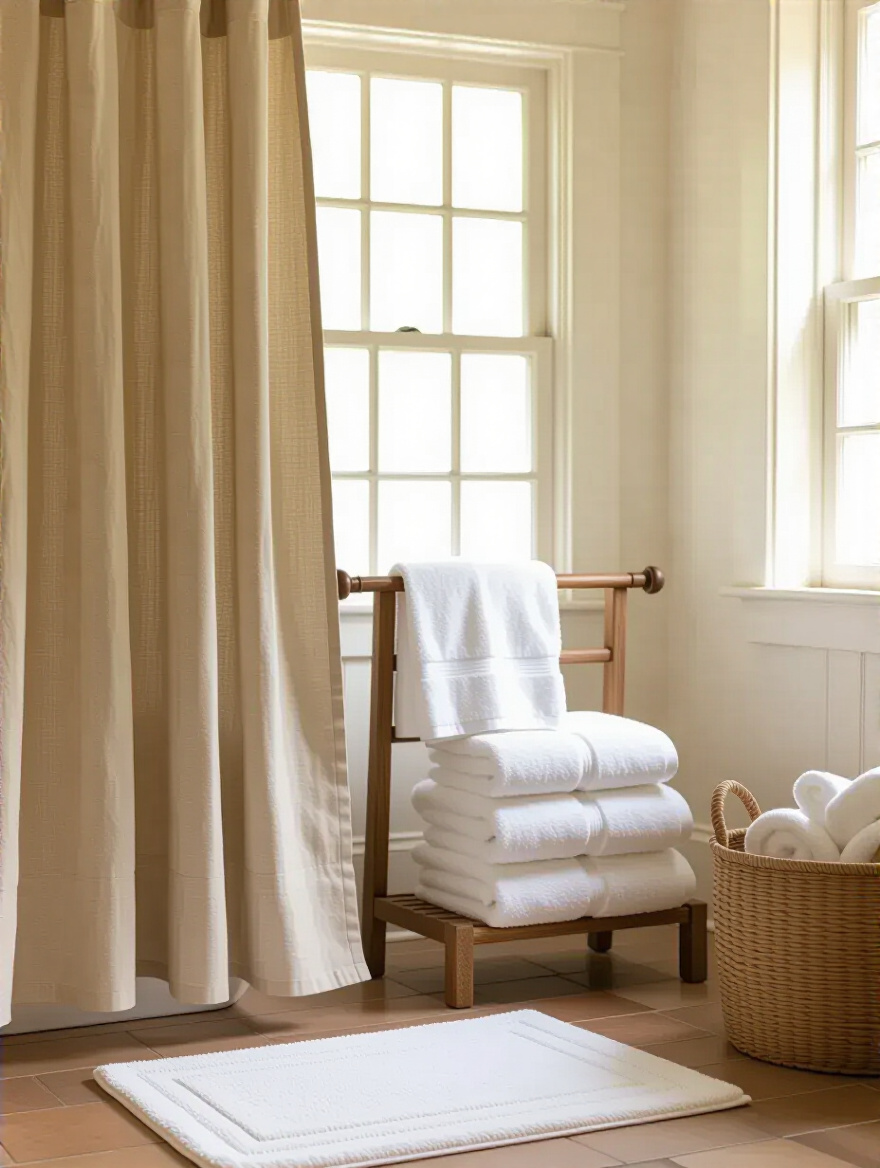
A heavy linen shower curtain has a beautiful drape and an earthy texture. Thick, plush cotton towels feel luxurious and are super absorbent. Look for simple weaves like a waffle or a classic terry cloth in natural, muted colors like cream, off-white, or a dusty blue.
These simple, high-quality textiles complete the tactile experience of the room. They provide a soft counterpoint to all the hard surfaces and make the space feel truly comfortable.
19. Add Thoughtful Historical Decorative Accents Discreetly
This is the final flourish, the part that makes the space feel personal and lived-in. But be careful. The goal is not to create a cluttered museum. The key is restraint. A few well-chosen objects are far more powerful than a shelf full of trinkets.
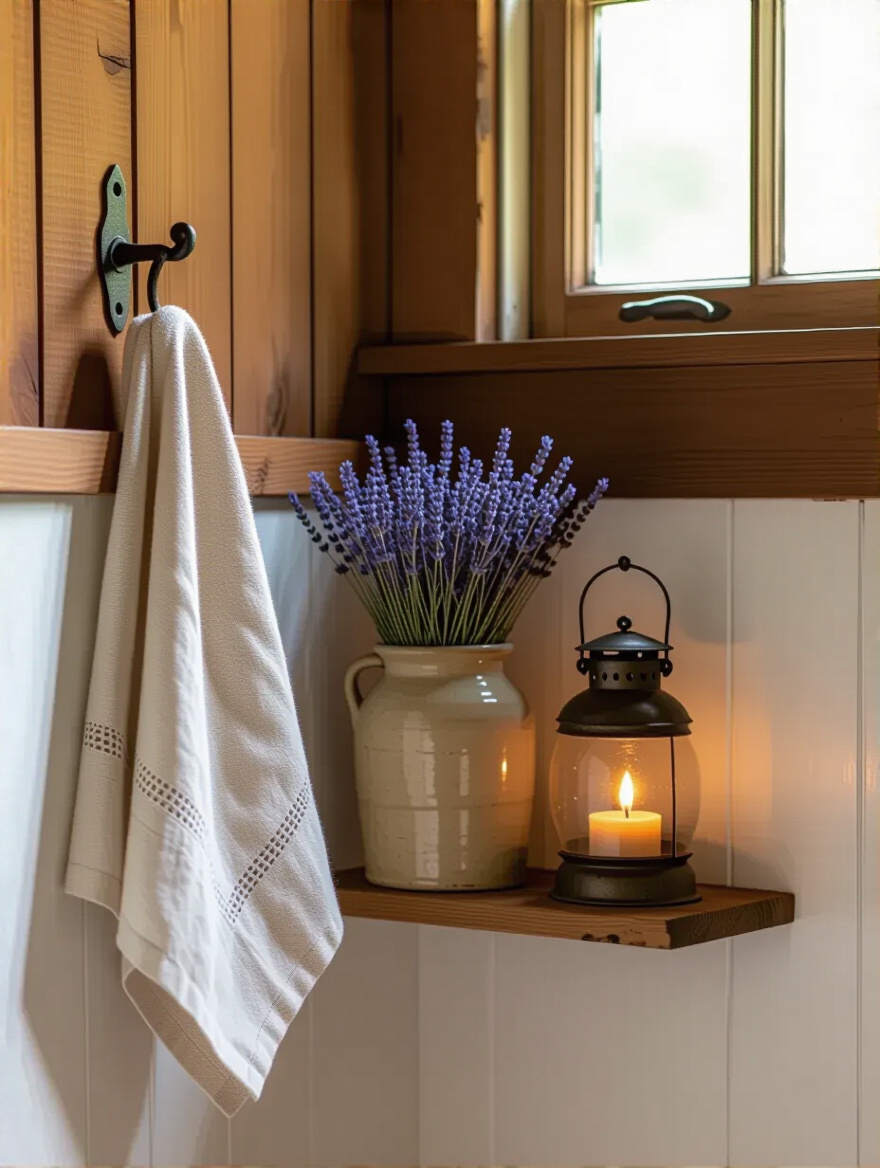
Think about things that feel like they belong. A set of antique-style apothecary jars for cotton balls. A small, framed botanical print on the wall. A simple stoneware crock for a toilet brush. A bar of handmade soap in a simple ceramic dish. These are small touches that tell a story and add character without creating clutter.
I always tell my clients to hunt for one or two authentic antique pieces from a local shop. A small wooden box or a single piece of old pottery has a soul that a reproduction can’t quite capture.
20. Discreetly Conceal Modern Bathroom Essentials
Nothing ruins the historical illusion faster than a bright blue plastic bottle of mouthwash or an electric toothbrush charging on the counter. Your final, and maybe most important, challenge is to hide all this modern stuff. This is the ultimate test of a thoughtfully designed space.
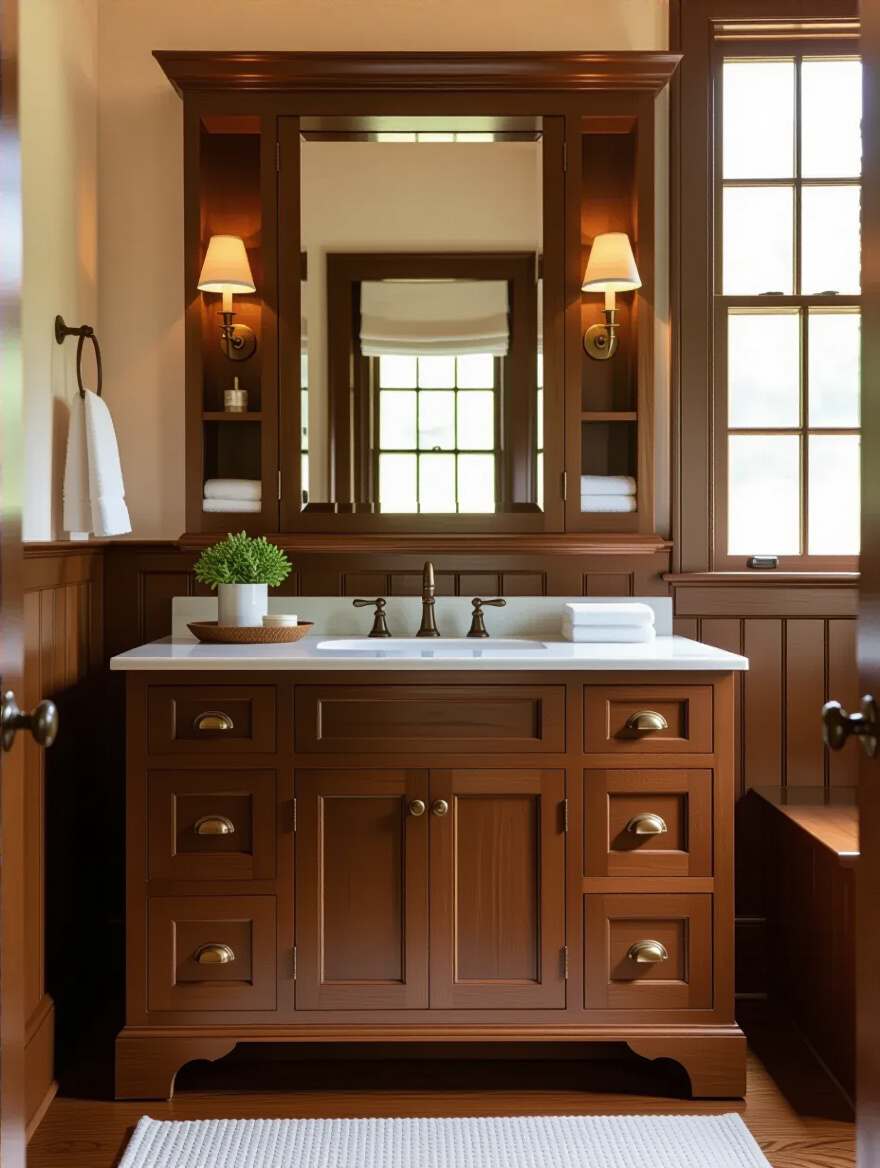
This is where recessed medicine cabinets with hidden internal outlets are a game-changer. Custom vanities can have pull-out drawers designed to hold a hairdryer. A beautiful lidded wicker basket on the floor can hold extra toilet paper. Use those decorative wooden boxes or ceramic jars to decant your lotions and soaps.
Your goal is an uncluttered countertop and a visual field free of modern plastic. It requires discipline, but the peaceful, serene result is more than worth the effort.
Refinement & Long-Term Care for Lasting Appeal
You’ve built your sanctuary. Congratulations! Now, here’s how you keep it feeling perfect. This isn’t about more construction; it’s about living with and caring for the beautiful space you’ve created so it lasts for decades.
21. Utilize Vintage-Inspired Accessories for Final Touches
I know we just talked about accents, but this is about the final edit. Live in the space for a week or two, and then take a fresh look. What does it need? Maybe a single, beautiful hook for a robe. Or a small stool beside the tub to hold a book and a cup of tea. It’s these small, functional additions that truly complete the room.
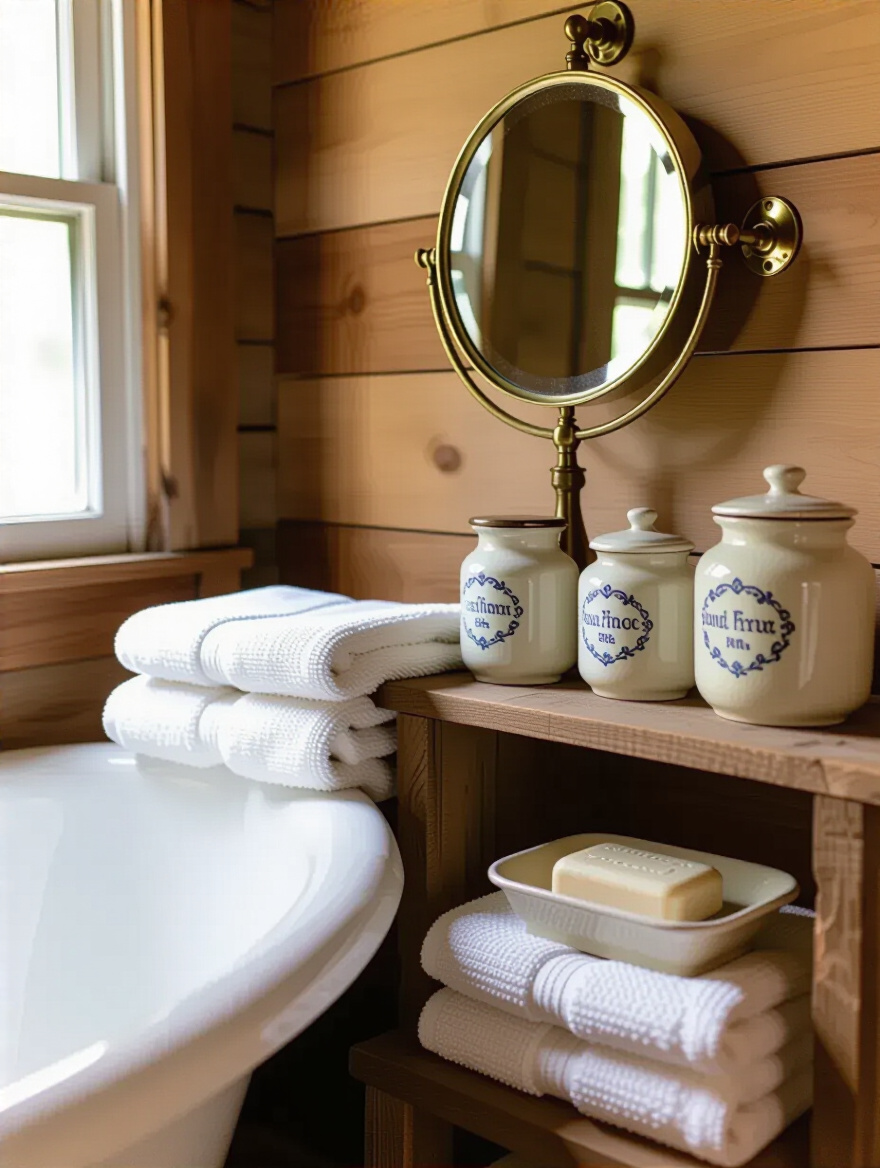
Think of it like adding the perfect piece of jewelry to an outfit. It’s the last detail that pulls everything together and makes it feel uniquely yours. It’s not about adding more stuff; it’s about adding the right stuff.
Once these final pieces are in place, stop. The beauty of this style is in its simplicity. Don’t be tempted to keep adding more.
22. Implement Period-Sympathetic Heating and Ventilation
Comfort is key, and that means staying warm and keeping the air fresh. But a big plastic vent cover in the middle of a plaster ceiling is a design crime. Again, the answer is to hide the modern tech. A powerful, quiet inline ventilation fan can be installed in the attic, with only a small, discreet, paintable grille visible in the bathroom.
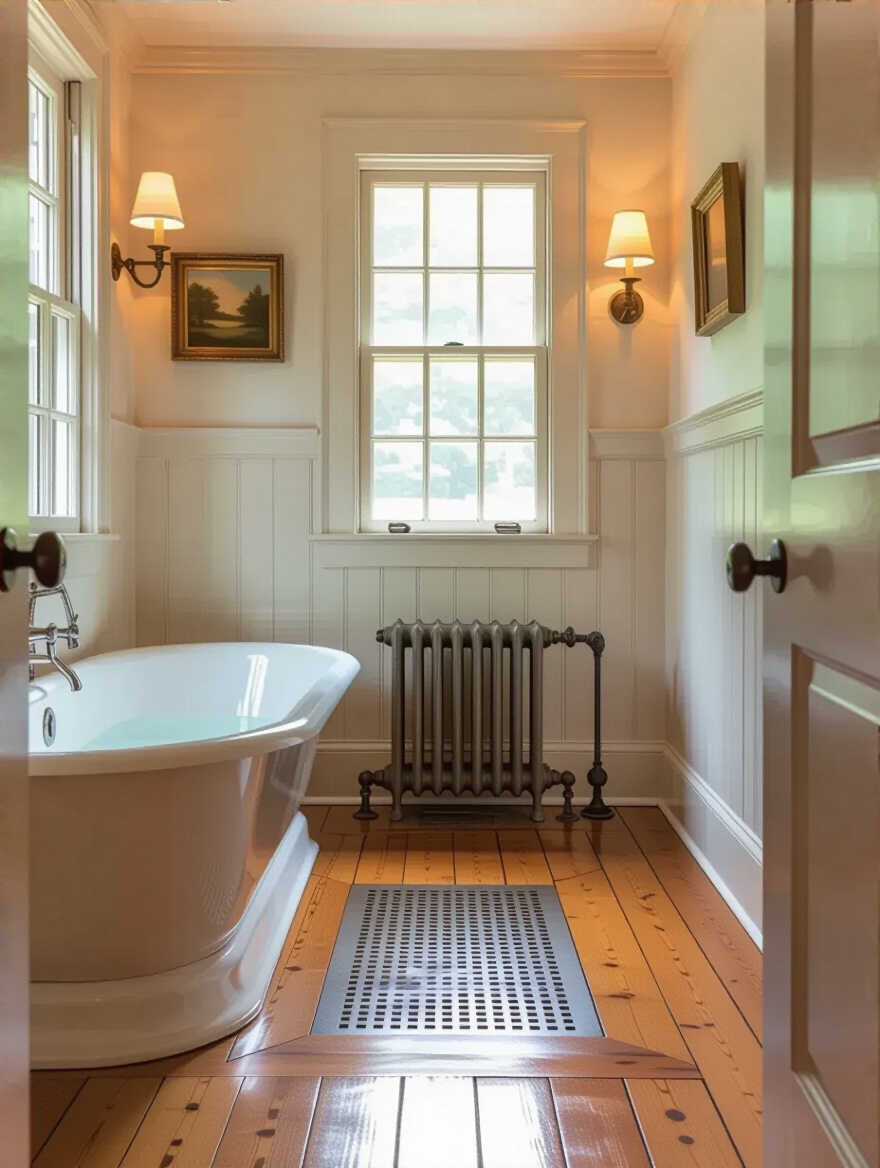
For heat, nothing beats silent, invisible radiant floor heating. But a beautifully restored cast-iron radiator can also be a stunning architectural feature that fits the period perfectly. The goal is to feel the comfort without necessarily seeing its source.
It’s another one of those “invisible modernization” tricks that makes a historic-feeling space truly livable and enjoyable year-round.
23. Master Cleaning Techniques to Preserve Historical Materials
Finally, you need to know how to care for what you’ve built. Do not—I repeat, DO NOT—attack your beautiful new bathroom with harsh, abrasive, all-purpose cleaners. They can destroy the finish on unlacquered brass, etch the porcelain on an antique tub, and strip the sealant from your wood floors.
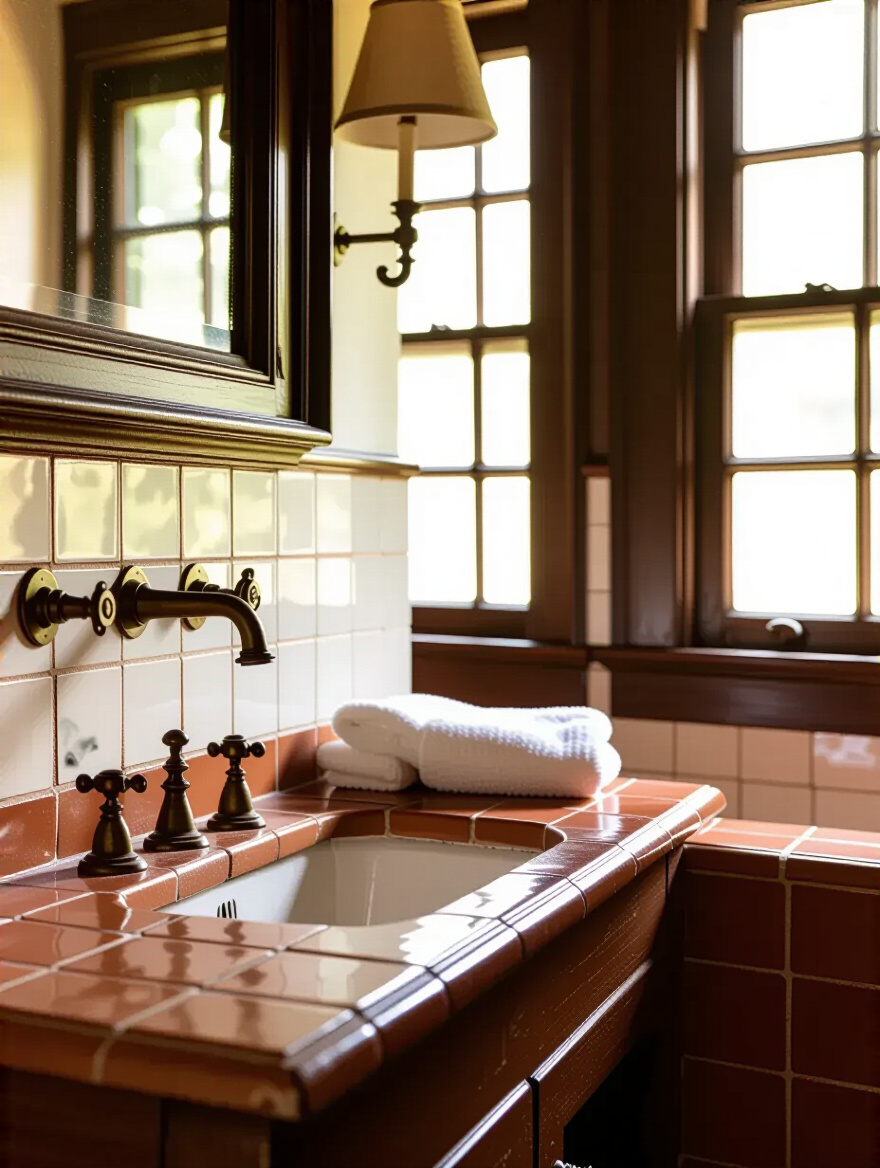
Gentle is the name of the game. Mild soap and water are your best friends. Microfiber cloths are better than abrasive sponges. For your brass, let it patina. A gentle wipe-down is all it needs. You’re not trying to keep it looking brand-new; you’re allowing it to age with grace. Learning to clean these materials properly will ensure your retreat stays beautiful for a very, very long time.
It’s the final act of respect for the craftsmanship and materials you so carefully chose.
Conclusion: Your Timeless Colonial Retreat Awaits
Creating a space like this is more than just a home renovation project. It’s an act of carving out a piece of the world for yourself that is deliberately quiet, slow, and beautiful. In our hyper-connected, always-on lives, building a sanctuary where you can truly disconnect and recharge isn’t a luxury; it’s a necessity. It’s the space that will give you the calm and clarity you need to tackle everything else.
You’re not just assembling fixtures and tile; you’re building a refuge. By focusing on the feeling, balancing authenticity with modern comfort, and layering in thoughtful details, you can create a bathroom that is so much more than a bathroom. It’s a retreat, a haven, and a testament to timeless design that will nourish your soul for years to come. Now, go and build your quiet corner of the world.
